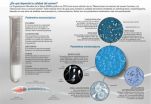(Press-News.org) COUPLES seeking to build a family, and surrogate mothers overseas who help them, are in danger of emotional, physical and financial exploitation unless UK authorities monitor and regulate the field much more closely, according to a University of Huddersfield professor who has published the results of a detailed investigation.
Eric Blyth – Professor of Social Work at the University of Huddersfield, and based at its Centre for Applied Childhood Studies – is co-author of The changing face of surrogacy in the UK, an article which charts the rapid increase in the numbers of surrogate births over the past six years. It warns that as surrogacy becomes more socially acceptable, there is a risk that more people will make informal arrangements that lack professional back-up.
"Without well-informed professionals, including child welfare and health professionals, there is a potential danger of parties being poorly informed and inadequately supported both during the surrogacy process itself and the years ahead," writes Professor Blyth and his co-authors Dr Marilyn Crawshaw (University of York) and Professor Olga van den Akker (Middlesex University) in the article, which appears in the Journal of Social Welfare and Family Law.
Since 1990, a UK couple wishing to become the legal parents of a child born to a surrogate mother must apply for a Parental Order. Initially this was restricted to married couples. In 2008, the rules were broadened so that same-sex couples were given the right to legal parentage following assisted-conception and surrogacy.
These wider criteria could help account for a big leap in the number of Parental Orders in England and Wales. From 1995 to 2007 they remained fairly steady, at between 36 and 52 a year. But in 2009 they climbed to 75 and in 2011 they stood at 149.
Surrogacy agencies had become established in the UK, but in recent years they have been involved in a smaller proportion of surrogacy arrangements.
"This is of some concern because agencies typically remain involved with the parties throughout the pregnancy and offer ongoing support," argues the article. A reduction in this could be disadvantageous for the parents, surrogates and the children affected.
Overseas surrogacy
The article's strongest warnings are in connection with overseas surrogacy arrangements. The global situation needs to be monitored in order to minimise the risk of exploitative developments, argue the authors.
"Such developments could include financial risk to the adults concerned, physical and emotional risk to both adults and children concerned and failure to afford due dignity and attention to the children and to the formation of family life. There are already some worrying indications that overseas arrangements may pose such risks."
The article cites episodes already exposed in the media such as a 'surrogacy ring' in Thailand in which 13 Vietnamese women had been trafficked for the purpose of acting as surrogates. And there have recent concerns that Indian women are also being exploited as surrogates.
The numbers of children born in India to UK commissioning parents could be considerably higher than the number of Parental Orders applied for, states the article. And the economic disparity between surrogates and commissioning couples also leads to fears of a market in babies.
Although calls were made ten years ago for closer monitoring and regulation of surrogacy arrangements – paying special heed to the potential for financial and other forms of exploitation – the study reveals that there are still insufficient data.
The authors conclude that the steep increase in the number of Parental Orders since 2008 means that there is a need for better systems of monitoring, recording and scrutiny, adding that: "The apparent increase in overseas arrangements that do not result in applications for Parental Ordersis a matter of considerable concern".
INFORMATION:
Crawshaw M. Blyth E. & van den Akker O. (2013). 'The changing profile of surrogacy in the UK – Implications for national and international policy and practice', Journal of Social Welfare and Family Law, DOI:10.1080/09649069.2012.750478
Increasing concerns surrounding surrogacy
2013-01-18
ELSE PRESS RELEASES FROM THIS DATE:
Semen quality of young men in south-east Spain down by 38 percent in the last decade
2013-01-18
The first comparative study on the evolution of sperm quality in young Spanish men over ten years, headed by researchers at the University of Murcia, reveals that spermatozoid concentration in men between 18 and 23 years in the regions of Murcia and Almeria has dropped by an annual average of 2%.
The suspicion that the semen of Spanish men is losing quality now takes force in the case of young men from Murcia and Almeria.
The 'Andrology' journal has published a multidisciplinary and international study, headed by the Department of Preventative Medicine and Public ...
Unrestricted access to the details of deadly eruptions
2013-01-18
Volcanic eruptions have the potential to cause loss of life, disrupt air traffic, impact climate, and significantly alter the surrounding landscape. Knowledge of the past behaviours of volcanoes is key to producing risk assessments of the hazards of modern explosive events.
The open access database of Large Magnitude Explosive Eruptions (LaMEVE) will provide this crucial information to researchers, civil authorities and the general public alike.
Compiled by an international team headed by Dr Sian Crosweller from the Bristol's School of Earth Sciences with support from ...
Breakthrough for solar cell research
2013-01-18
In the latest issue of Science, researchers from Lund University in Sweden have shown how nanowires could pave the way for more efficient and cheaper solar cells.
"Our findings are the first to show that it really is possible to use nanowires to manufacture solar cells", says Magnus Borgström, a researcher in semiconductor physics and the principal author.
Research on solar cell nanowires is on the rise globally. Until now the unattained dream figure was ten per cent efficiency – but now Dr Borgström and his colleagues are able to report an efficiency of 13.8 per cent. ...
Climate change to profoundly affect the Midwest in coming decades
2013-01-18
ANN ARBOR—In the coming decades, climate change will lead to more frequent and more intense Midwest heat waves while degrading air and water quality and threatening public health. Intense rainstorms and floods will become more common, and existing risks to the Great Lakes will be exacerbated.
Those are some of the conclusions contained in the Midwest chapter of a draft report released last week by the federal government that assesses the key impacts of climate change on every region in the country and analyzes its likely effects on human health, water, energy, transportation, ...
ARS scientists test improved stink bug trapping methods
2013-01-18
This press release is available in Spanish.
Baited black traps in a pyramid shape attract significantly more brown marmorated stink bugs than other traps, according to U.S. Department of Agriculture (USDA) scientists. Evaluating stink bug responses to different visual stimuli may help manufacturers design better traps for monitoring the bugs.
Entomologist Tracy Leskey at the Agricultural Research Service (ARS) Appalachian Fruit Research Station in Kearneysville, W.V., focused on visual stimuli that can attract the stink bugs to traps that will help farmers monitor ...
Studying ancient Earth's geochemistry
2013-01-18
Washington, D.C.— Researchers still have much to learn about the volcanism that shaped our planet's early history. New evidence from a team led by Carnegie's Frances Jenner demonstrates that some of the tectonic processes driving volcanic activity, such as those taking place today, were occurring as early as 3.8 billion years ago. Their work is published in Geology.
Upwelling and melting of the Earth's mantle at mid-ocean ridges, as well as the eruption of new magmas on the seafloor, drive the continual production of the oceanic crust. As the oceanic crust moves away ...
Wild animals may contribute to the resurgence of African sleeping sickness
2013-01-18
Wild animals may be a key contributor to the continuing spread of African sleeping sickness, new research published in PLOS Computational Biology shows. The West African form of the disease, also known as Gambiense Human African trypanosomiasis, affects around 10,000 people in Africa every year and is deadly if left untreated.
The disease is caused by a brain-invading parasite transmitted by bites of the tsetse fly, and gets its name from the hallmark symptoms of drowsiness and altered sleeping patterns that affect late-stage patients, along with other physical and neurological ...
Factors linked with survival differences between Black, White kidney failure patients
2013-01-18
Highlights
Residence in areas with higher average household income was linked with improved survival in kidney failure patients.
In White patients, income inequality was associated with mortality.
In Black patients exclusively, residence in highly segregated areas was associated with increased mortality.
More than 590,000 Americans in 2010 were treated for kidney failure.
Washington, DC (January 17, 2013) — Complex socioeconomic and residential factors may account for differences in survival between Black and White kidney failure patients, according to a study ...
Climate events drive a high-arctic vertebrate community into synchrony
2013-01-18
Climate change is known to affect the population dynamics of single species, such as reindeer or caribou, but the effect of climate at the community level has been much more difficult to document. Now, a group of Norwegian scientists has found that extreme climate events cause synchronized population fluctuations among all vertebrate species in a relatively simple high arctic community. These findings may be a bellwether of the radical changes in ecosystem stability that could result from anticipated future increases in extreme events. The findings are published in the ...
Scientists expose new vulnerabilities in the security of personal genetic information
2013-01-18
CAMBRIDGE, Mass. (January 17, 2013) – Using only a computer, an Internet connection, and publicly accessible online resources, a team of Whitehead Institute researchers has been able to identify nearly 50 individuals who had submitted personal genetic material as participants in genomic studies.
Intent on conducting an exercise in “vulnerability research”—a common practice in the field of information security—the team took a multi-step approach to prove that under certain circumstances, the full names and identities of genomic research participants can be determined, ...


